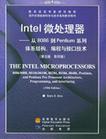Intel微处理器
2001-8
高等教育出版社
Barry B.Brey
967
1464000
无
Intel微处理器已经在电子、通信、控制系统和桌面计算机系统等领域得到了广泛的应用。本书从实用的角度出发,全面介绍了Intel系列微处理器的编程和接口技术。主要内容包括:微处理器的编程模式和系统结构;Intel系列微处理器指令;在C/C++程序中编制汇编程序模块;存储器接口;基本输入/输出技术;数值协处理器及MMX技术;总线接口;8086/8088、80186/80188~80486、Pentium系列微处理器等。与第四版相比,本书增加了如何将汇编语言与C/C++结合起来编程、USB接口、MMX技术及PentiumⅡ等内容。书中列举了大量实例,具有较强的实用性;本书内容系统,结构合理,叙述详尽,每章前有学习目标、章后有小结及习题,并配有大量图表,易为读者接受。此外,本书内容较新,使读者能够把握技术发展的前沿。本书可作为高等校院相关课程教材。对于希望掌握Intel微处理器编程和接口技术的读者来说,本书也是一本很好的参考书。 内容:1. 微处理器及计算机系统概述 2. 微处理器及其系统结构 3. 寻址方式 4. 数据传送指令 5. 算术与逻辑指令 6. 程序控制指令 7. 微处理器编程技术 8. 在C/C+中使用汇编语言 9. 8086/8088硬件性能指标 10. 存储器接口 11. 基本输入/输出接口 12. 中断 13. 直接存储器存取(DMA)和DMA控制的I/O 14. 数值协处理器和MMX技术 15. 总线接口 16. 80186,80188及80286微处理器 17. 80384和80486微处理器 18. Pentium和Pentium Pro 微处理器 19. PentiumⅡ微处理器 附录A 汇编程序、DOS、BIOS、鼠标和DPMI内存管理器 B 指令集汇总 C 标志位变化表 D 偶数题号习题答案 索引
1 Introduction to the Microprocessor and Computer Introduction/Chapter Objectives 1-1 A Historical Background 1-2 The Microprocessor-Based Personal Computer System 1-3 Number Systems 1-4 Computer Data Formats 1-5 Summary 1-6 Questions and Problems 2 The Microprocessor and its Architecture Introduction/Chapter Objectives 2-1 Internal Microprocessor Architecture 2-2 Real Mode Memory Addressing 2-3 Introduction to Protected Mode Memory Addressing 2-4 Memory Paging 2-5 Summary 2-6 Questions and Problems 3 Addressing Modes Introduction/Chapter Objectives 3-1 Data-Addresing Modes 3-2 Program Memory-Addressing Modes 3-3 Stack Memory-Addressing Modes 3-4 Summary 3-5 Questions and Problems 4 Data Movement Instructions Introduction/Chapter Objectives 4-1 MOV Revisited 4-2 PUSH/POP 4-3 Load-Effective Address 4-4 String Data Transfers 4-5 Miscellaneous Data Transfer Instructions 4-6 Segment Override Prefix 4-7 Assembler Detail 4-8 Summary 4-9 Questions and Problems 5 Arithmetic and Logic Instructions Introduction/Chapter Objectives 5-1 Addition, Subtraction, and Comparison 5-2 Multiplication and Division 5-3 BCD and ASCII Arithmetic 5-4 Basic Logic Instructions 5-5 Shift and Rotate 5-6 String Comparisons 5-7 Summary 5-8 Questions and Problems 6 Program Control Instructions Introduction/Chapter Objectives 6-1 The Jump Gorup 6-2 Controlling the Flow of an Assembly Language Program 6-3 Procedures 6-4 Introduction to Interrrupts 6-5 Machine Control and Miscellaneous Instructions 6-6 Summary 6-7 Questions and Problems 7 Programming the Microprocessor Introduction/Chapter Objectives 7-1 Modular Programming 7-2 Using the Keyboard and Video Display 7-3 Data Conversions 7-4 Disk Files 7-5 Example Programs 7-6 Interrupt Hooks 7-7 Summary 7-8 Questions and Problems 8 Using Assembly Language with C/C++ Introduction/Chapter Objectives 8-1 Using Assembly Language with C/C++ for 16-bit Applications 8-2 Using Assembly Language with C/C++ for 32-bit Applications 8-3 Separate Assembly Objects 8-4 Summary 8-5 Questions and Problems 9 8086/8088 Hardware Specifications Introduction/Chapter Objectives 9-1 Pin-Outs and Pin Functions 9-2 Clock Generator (8284A) 9-3 Bus Buffering and Latching 9-4 Bus Timing 9-5 Ready and the Wait State 9-6 Minimum Mode Verse Maximum Mode 9-7 Summary 9-8 Questions and Problems 10 Memory Interface Introduction/Chapter Objectives 10-1 Memory Devices 10-2 Address Decoding 10-3 8088 and 80188 (8-bit) Memory Interface 10-4 8086, 80186, 80286, and 80386SX (16-bit) Memory Interface 10-5 80386DX and 80486 (32-bit) Memory Inteface 10-6 Pentium, Pentium Pro, and Pentium II (64-bit) Memory Interface 10-7 Dynamic RAM 10-8 Summary 10-9 Questions and Problems 11 Basic I/O Interface Introduction/Chapter Objectives 11-1 Introduction to I/O Interface 11-2 I/O Port Address Decoding 11-3 The Programmable Peripheral Interface 11-4 The 8279 Programmable Keyboard/Display Interface 11-5 8254 Progammable Interval Timer 11-6 16550 Programmable Communications Interface 11-7 Analog-to-Digital (ADC) and Digital-to-Analog (DAC) Conversions 11-8 Summary 11-9 Questions and Problems 12 Interrupts Introduction/Chapter Objectives 12-1 Basic Interrupt Processing 12-2 Hardware Interrupts 12-3 Expanding the Interrupt Structure 12-4 8259A Programmable Interrupt Controller 12-5 Interrupt Examples 12-6 Summary 12-7 Questions and Problems 13 Direct Memory Access and DMA-Controlled I/O Introduction/Chapter Objectives 13-1 Basic DMA Operation 13-2 The 8237 DMA Controller 13-3 Shared-Bus Operation 13-4 Disk Memory Systems 13-5 Video Displays 13-6 Summary 13-7 Questions and Problems 14 The Arithmetic Coprocessor and MMX Technology Introduction/Chapter Objectives 14-1 Data Formats for the Arithmetic Coprocessor 14-2 The 80X87 Architecture 14-3 Instruction Set 14-4 Programming with the Arithmetic Coprocessor 14-5 Introduction to MMX Technology 14-6 Summary 14-7 Questions and Problems 15 Bus Interface Introduction/Chapter Objectives 15-1 The ISA Bus 15-2 The Extended ISA (EISA) and VESA Local Buses 15-3 The Peripheral Component Interconnect (PCI) Bus 15-4 The Universal Serial Bus (USB) 15-5 Accelerated Graphics Port (AGP) 15-6 Summary 15-7 Questions and Problems16 The 80186, 80188, and 80286 Microprocessors Introduction/Chapter Objectives 16-1 80186/80188 Architecture 16-2 Programming the 80186/80188 Enhancements 16-3 80C188EB Example Interface 16-4 Introduction to the 80286 16-5 Summary 16-6 Questions and Problems 17 The 80386 and 80486 Microprocessors Introduction/Chapter Objectives 17-1 Introduction to the 80386 Microprocerssor 17-2 Special 80386 Registers 17-3 80386 Memory Management 17-4 Moving to Protected Mode 17-5 Virtual 8086 Mode 17-6 The Memory Paging Mechanism 17-7 Introduction to the 80486 Microprocessor 17-8 Summary 17-9 Questions and Problems 18 The Pentium and Pentium Pro Microprocessors Introduction/Chapter Objectives 18-1 Introduction to the Pentium Microprocessor 18-2 Special Pentium Registers 18-3 Pentium Memory Management 18-4 New Pentium Instructions 18-5 Introduction to the Pentium Pro Microprocessor 18-6 Special Pentium Pro Features 18-7 Summary 18-8 Questions and Problems 19 The Pentium II Microprocessor Introduction/Chapter Objectives 19-1 Introduction to the Pentium II Microprocessor 19-2 Pentium II Software Changes 19-3 Summary 19-4 Questions and Problems Appendix A The Assembler, Disk Operating System, Basic I/O System, Mouse, and DPMI Memory ManagerAppendix B Instruction Set SummaryAppendix C Flag-Bit ChangesAppendix D Answers to Selected Even-Numbered Questions and Problems

无
用的着
书有污渍和破损,美中不足
价钱便宜,印刷也不错